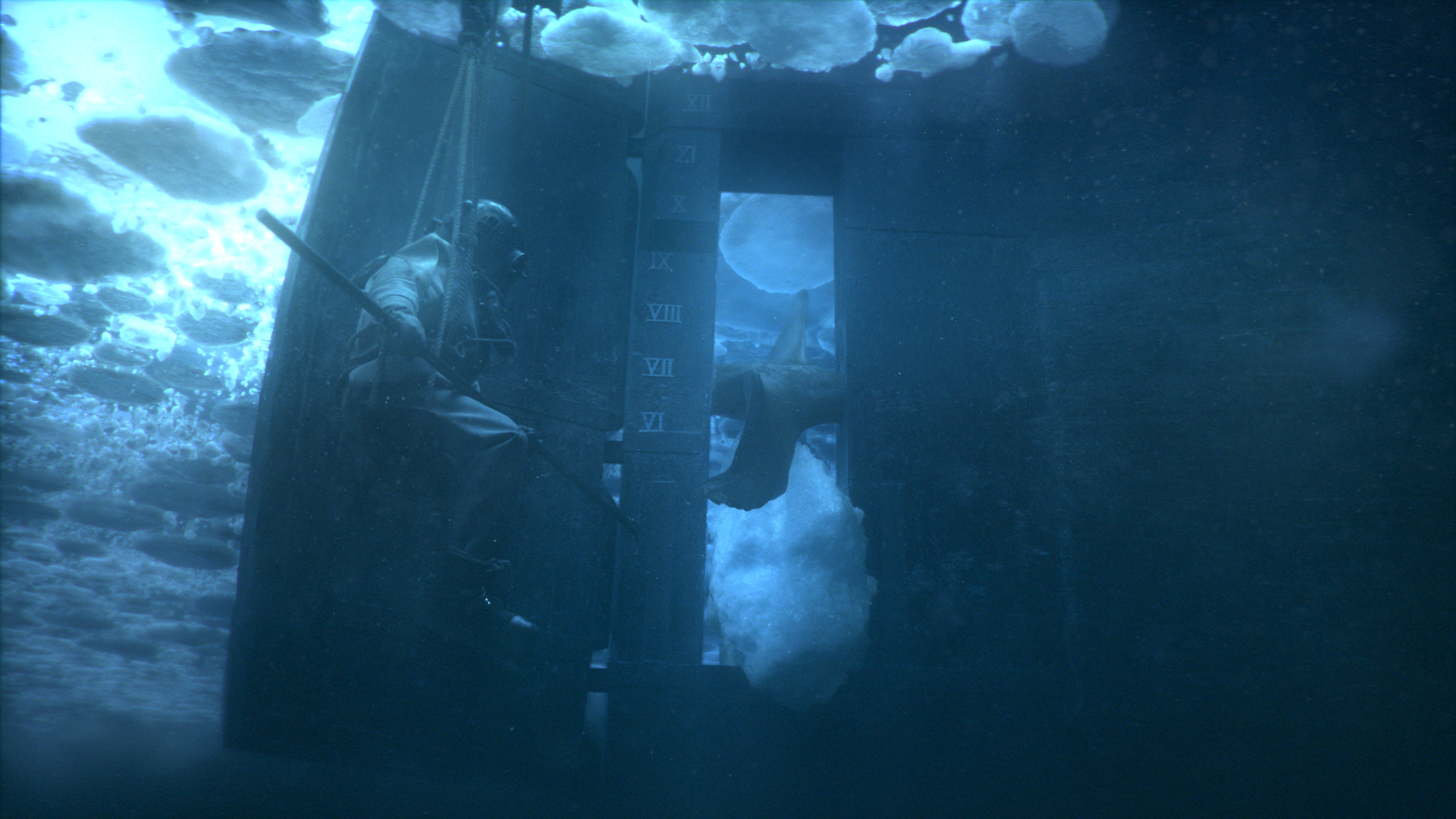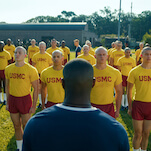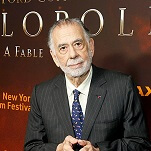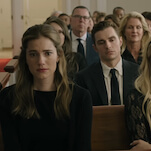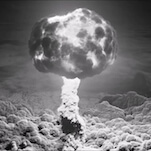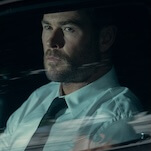“Past hope. Past kindness or consideration. Past justice. Past warmth or cold or comfort. Past love. But past surprise? What an endlessly unfolding tedium life would then become!” —Francis Wolcott, Deadwood
The men of the Royal Navy about whose lives and deaths The Terror concerns itself have set out on an expedition into the unknown, but the show itself is not. Carefully researched, meticulously art-directed dramas about the evil that heavily accented, infrequently bathed men did back in the olden days are as common across the TV landscape as ice in the Arctic. (At least, as common as ice in the Arctic used to be.) In too many of these cases, hitting that one note of grim, grimy gloom seems to have been viewed as sufficient by the filmmakers involved.
What The Terror gets right, and so many other works of period miserabalism—including executive producer Ridley Scott’s own Taboo, starring a soot-encrusted Tom Hardy—get wrong, is that you have to feel bad that the characters are so miserable in the first place. If you start them all at the same glowering, fundamentally mean-spirited place and just make things worse from there, that empathy can’t be generated; you’re left with the “endlessly unfolding tedium” that the granddaddy of the genre once described. Deadwood never fell into that trap, and neither, based on this opening hour, does The Terror.
Based on Dan Simmons’s 2007 doorstop of a novel, The Terror is a ripped-from-the-170-year-old headlines story of survival and horror among the crews of the titular vessel and its sister ship, the HMS Erebus, during a disastrous exploratory mission to open the Northwest Passage through the ice-choked waters of Canada. The ships set out in 1845 and were never seen again, leaving only reports by the Inuit locals of starving men, a note not found for over a decade, and the discovery of disease-ridden, possibly cannibalized corpses behind as clues to their final location. The two wrecks weren’t located in the frozen wastes until 2014 and 2016, leaving over a century and a half of speculation in their wake. The Terror is an attempt to fill in those blanks with elegantly brutal fiction, as the sailors battle relentlessly worsening physical and mental conditions—and, perhaps, the ill intent of a supernatural enemy as well.
“Go for Broke” introduces us to the crew whose sorry fate we’ll be studying for the duration of the season. They’re led by Sir John Franklin, the expedition’s stiff-upper-lip steady-on-old-chap leader, played by the wonderfully weathered character actor Ciarán Hinds. He’s seldom far from the side of his second in command aboard the Erebus, a young officer who fancies himself something of a swashbuckler named Captain James Fitzjames (Hinds’s fellow Game of Thrones veteran Tobias Menzies). Franklin’s counterpart across the icy water on the Terror is Captain Francis Crozier; played by Jared Harris, humming with an even more intense level of the mesmerizingly melancholic energy he brought to his role as Lane Pryce on Mad Men, Crozier is a drunk and an Irishman (that’ll do with the jokes, thanks) who’s clearly suffering from some as-yet unspoken trauma. As officers, they’re afforded a comparatively lavish lifestyle with all the creature comforts, and even a pair of comforting creatures, a monkey and a dog. Yet the sniping between the world-weary Frazier and the arrogant Fitzjames is a bigger rift right now than any between the brass and the rank-and-file.
As summer wanes and the ice grows more treacherous amid the water—leading to an accident that sends a man overboard, our first casualty of the series—the trio preside over an understandably nervous but generally game crew. Standouts include Henry Collins (Trystan Gravelle), sent beneath the surface in a diver’s suit in an attempt to repair the Erebus’ damaged propeller in the episode’s most nerve-wracking sequence (even before the corpse of the lost crewmember floats up); David Young (Alfie Kingsnorth), a jocular young sailor who bloodily succumbs to an undiagnosed internal disorder; Dr. Henry Goodsir (Paul Ready), the low-ranking ship surgeon with a disposition as gentle as his surname suggests who treats, comforts, and eventually autopsies Young; and Cornelius Hickey (Adam Nagaitis), a goateed petty officer who gives voice to some of the men’s thus-far mild complaints and who insists upon repairing Young’s broken coffin when it’s damaged during his burial, an act of well-meaning rebellion that’s set up in such a way as to imply it may be (sorry) the tip of the iceberg.
So far, director Edward Berger and writer David Kajganich (the series’ creator and, with Soo Hugh, co-showrunner) feel little need to hard-sell the threat of the inhospitable realm into which these self-described “argonauts” have voyaged; just taking a look around is all you need. The deep blue water and eerie round ice formations floating in it are a textbook example of the genre-fiction phrase “terrible beauty,” while the incessant creaking and cracking and cold convey just how flimsy the protection provided by the two wooden ships will be if things get really bad, which we know from the introductory text that they will. In fact, another of the episode’s most unnerving moments occurs when the constant low rumbling and sloshing finally stops: The silence wakes Sir John from his slumber, since he knows it means the ship has been frozen stuck and can go no further for months. The episode’s title, “Go for Broke,” comes from Sir Francis’s advice to abandon the damaged ship, change course due east, and winter safely in a protected harbor rather than forge on, advice Franklin rejected to his now-visible regret.
Yet despite Sir John’s miscalculation—and here we get back to the heart of the matter—he’s not the unsympathetic figure you might expect. Yes, his view of the expedition’s fortunes is far too rosy, and at times he seems oblivious to the mood of his men. But it’s possible to see his glass-half-full attitude not as hopelessly hubristic, but rather as an attempt to model optimism under dangerous circumstances. Does he demand that the ailing Young be moved from the Terror to the Erebus against medical advice because he doesn’t care about the kid’s health, or because it’s better for his crewmates if those who know him best aren’t around to watch and hear him die? Does he sell their winter in the treacherous icepack—which floats in glacial fashion even as the ships remain bound fast in it, meaning they could wind up countless miles off course by springtime—as the “adventure of a lifetime” because he believes it, or because that’s what the crew needs to hear? Keep in mind that even as he dies, Young seems to love Sir John like a father, while Franklin defends Crozier’s honor against Sir James’s insults. There’s a decency in there, brought out by the warmth in Hinds’s eyes.
The Samwell Tarly-esque Dr. Goodsir is an even more innately likeable figure, valiantly working to comfort his dying patient without offering false hope of recovery; it’s Goodsir who takes the man’s final moments of terror, in which he speaks to an apparition of an indigenous shaman only he can see, as a question that merits answering rather than a hallucination to be ignored. On the flipside, Sir Francis may be right about what the expedition should have done, but he has the surly disposition of a man who’s drinking to blot out the world; only in comparison to the ego of his rival Sir James does he come across as the guy whose side you should take.
In other words, the The Terror isn’t trying to impress its prestigeness upon you by making everything as nasty and extreme as possible. These may be humans under almost unimaginable pressure, but they’re still recognizably human. That’s vital. Whatever else it is, this is a workplace drama, and coworkers need to get along, at least for a while, before everything falls apart.
Stray observations
- Complementing the unforgiving alien landscape is a bracingly discordant score by the late composer Marcus Fjellström. When it’s not present, you feel the absence just as keenly as Sir John Franklin felt the disappearance of the sounds of the ship’s progress.
- Necessity is the mother of invention, and the network-mandated commercial breaks enable some striking cuts to black. I was particularly struck by how quickly the show screeched to a halt when Mr. Collins, fresh from his nightmarish submersion, told the too-genial Sir John that the voyage was “like a dream, sir.” That dream ended real quick.
- Whenever people of color are used as vessels of magic and mystery by a story, it’s right and proper to view it with suspicion. So far, though, I’m mollified by how matter-of-fact the appearance of that masked man to the dying sailor was. You see Young, cowering in his bed, then you cut to the corner, where someone who shouldn’t be there is there. It’s like Danny turning the corner in the Overlook Hotel and seeing old Grady’s dead daughters. The technique doesn’t unnecessarily exoticize the specter.
- When the ships come to a halt, you can hear Sir Francis’s mental “I told you so” to Sir John clear across the arctic.
- What a great use of a flashback: Sir Francis’s memories of happier times with his naval colleagues at a lavish theatrical performance in their honor back home, with a cheering crowd and a color palette of radiant gold, are jumbled up and tossed aside for the final overhead shot of the two ships stuck in the silent, blue-white snowy wastes.
- “There’s nothing worse than a man who’s lost his joy.”
- “We don’t appear to be sinking. Wake me if that should change.”
- “Sometimes I think you love your men more than even God loves them, Sir John.” “For all your sakes, I hope you’re wrong.”
